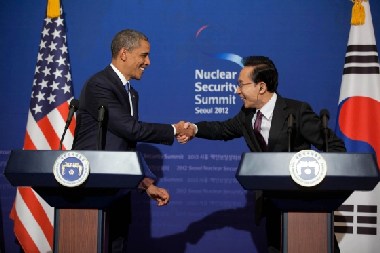The synergies between nuclear safety and security were highlighted at the 2012 Nuclear Security Summit in Seoul, where world leaders concluded that the right to develop and use nuclear energy for peaceful purposes must not be hampered by measures to strengthen nuclear security.
 |
| US President Barack Obama and South Korean President Lee Myung-bak at the Seoul summit (Image: White House/Chuck Kennedy) |
The two-day Seoul meeting saw leaders from 53 countries gather to review progress made in the two years since the inaugural Washington summit, and to set out the further measures that countries must take to prevent nuclear and radiological terrorism. Those measures are set out in the summit's official outcome: the unanimously agreed Seoul Communiqué.
The communiqué reaffirms the leaders' political commitment to work to strengthen nuclear security, reduce the threat of nuclear terrorism, and prevent the acquisition of nuclear materials by "terrorists, criminals, or other unauthorized actors." At its core lies the fundamental responsibility of individual states to maintain effective nuclear security, alongside the need for international cooperation, voluntary efforts at the state level to minimize nuclear material, the central role of the International Atomic Energy Agency (IAEA), and the right to peaceful uses of nuclear energy.
Driving away from HEU
The particular risks presented by highly enriched uranium (HEU) and separated plutonium have been a particular source of focus for the summit. As well as re-emphasizing the importance of making sure that such materials are appropriately secured and accounted for, the leaders joined together in encouraging individual states to minimize the use of HEU. Uranium fuel enriched to around 20% uranium-235 - HEU fuel - can be used to fuel the research reactors used to manufacture radioisotopes for use in medicine and industry. It is also used in the target plates irradiated inside the reactors to make the isotopes themselves. However, some fuels that fall in this category are weapons-useable material and therefore it is viewed as a proliferation risk.
Obama praises nuclear benefits
US President Barack Obama took the opportunity of an address at Hankuk University on the eve of the summit to sing the praises of peaceful nuclear power. "Let's never forget the astonishing benefits that nuclear technology has brought to our lives," he told his audience. After Fukushima, it was only "right and appropriate" that the world's nations took further steps to improve safety and security at nuclear facilities, and this was happening "all across the world." He noted that enhanced nuclear security also enhances the peaceful use of nuclear energy and pointed to US commitments to invest in its restarted nuclear energy industry. "I urge nations to join us in seeking a future where we harness the awesome power of the atom to build and not destroy," he said.
Moves to address this risk by converting research reactors to use low enriched uranium (LEU) fuel started as long ago as 1978, when the US Reduced Enrichment for Research and Test Reactors was launched. That program was subsequently subsumed into the US National Nuclear Security Administration's Global Threat Reduction Initiative (GTRI), established in 2004.
Now, the world leaders have gone a stage further, not only encouraging states to convert reactors to use LEU fuel where technically and economically feasible, taking into account the need for assured supplies of isotopes, but also asking states to promote the use of LEU fuels and targets in commercial applications. The leaders also called on states to announce voluntary specific measures to minimize HEU use by 2013.
Some states were quick to comply. The first day of the summit saw a trilateral agreement between the USA, Mexico and Canada to convert Mexico's research reactor to LEU fuel and two joint statements by Belgium, France, the Netherlands and the USA on cooperation on minimizing the use of HEU in the production of the medical isotopes.
Today, Sweden's foreign minister Carl Bildt announced in a Dagens Nyheter article that 3 kilograms of plutonium from reprocessing research in the 1950s and 1960s had been sent to the USA for destruction. He said it was the first time reprocessed plutonium had been handled under the GTRI framework, adding that small amounts of the plutonum had come from the UK and USA for weapons research. International Nuclear Services confirmed to World Nuclear News that it undertook the shipment using its specialised Oceanic Pintail vessel with support from an escort of the UK's Civil Nuclear Constabulary.
Noting landmarks
Summing up at the end of the summit, South Korean President Lee Myung-bak highlighted worldwide progress on the reduction of HEU and plutonium, both in terms of volume reduction and removal of HEU from eight countries over the past two years. On the eve of the summit, the removal of the final shipment of HEU from Ukraine was announced, honouring a pledge made at the 2010 summit.
Praising the leaders for their "hard work and dedication," Lee promised that summit-level commitments would be translated into specific domestic measures by individual countries. "I believe that it is our joint responsibility to work towards making a community of peace where humankind live peacefully together by contributing to world nuclear security," he said.
The next Nuclear Security Summit will be held in the Netherlands in 2014.
Researched and written
by World Nuclear News




_18570.jpg)
_18938.jpg)
_33584.jpg)
_82983.jpg)





